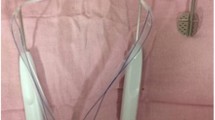Abstract
Aim
To evaluate perioperative and postoperative complications of mini sling operations in the surgical treatment of female urinary incontinence.
Methods
The study was comprised of 151 female patients with stress urinary incontinence (SUI) or mixed incontinence (MUI) with predominant SUI patients who underwent the mini sling procedure. The duration of the follow-up ranged from 6 to 21 months. All women had positive cough stress tests preoperatively. The procedure was performed under local (86.1 %) or spinal anesthesia (13.9 %) with the same mini slings for all cases. Patients were examined in the outpatient clinic at 1 and 6 months after surgery.
Results
The mean age was 49 years old (SD 10) with a range of 26–82. Of the 151 patients, 42 (27.8 %) presented MUI, while 109 (72.2 %) presented SUI. Mean parity was 3 ± 1. Mean body mass index was 28.9 ± 3.5. 60 (39.7 %) of the cases were postmenopausal. There were 73 women who participated in 6 months follow-ups and 78 women who did 1-year follow-ups. The mean operating time was 13 ± 3.1 min. There were no major intraoperative complications due to mini sling surgery. 120 (79.5 %) patients were discharged the day following the surgery. Ten patients (6.1 %) had de novo urge incontinence in their post-operative follow-ups which was resolved using anti-cholinergic drugs. Two patients (1.2 %) required sling sections due to prolonged bladder outlet obstruction. There were 15 patients that complained about de novo dyspareunia (9.9 %). Vaginal mesh extrusion was reported in 18 (11.9 %) patients. The mean preoperative and postoperative hemoglobin concentrations were 12.9 ± 1.3 and 12.5 ± 1.3 g/dL, respectively.
Conclusion
The mini sling system can be considered an easy and effective method for treating stress urinary incontinence without major complication rates.
Similar content being viewed by others
References
Ogah J, Cody DJ, Rogerson L (2011) Minimally invasive synthetic suburethral sling operations for stress urinary incontinence in women: a short version Cochrane review. Neurourol Urodyn 30(3):284–291
Smith P, Arunkalaivanan A, Baptiste M (2011) Single-ıncision midurethral tape (Ophira™) vs. Transobturator Tape (Obtryx™): prospective comparative study at a median follow-up of 6 months. 36th Annual Meeting of the International Urogynecological Association. Lisbon, Portugal. Abstract#181 Int Urogynecol J vol 22, Supplement 1. City Hosp., Birmingham, pp 1–195
Enzelsberger H, Cemer I, Kostersitz E, Enzelsberger S (2011) Ophira® (Minisling) versus Monarc® (Tot): a prospective randomized study for the treatment of female stress urinary ıncontinence at a follow-up of 20 months. 36th Annual Meeting of the International Urogynecological Association. Abstract#281. Lisbon, Portugal
Cetinel B, Ozkan B, Can G (2004) The validation study of ICIQ-SF Turkish version. Turkish J Urol 30(3):332–338
Cam C, Sakalli M, Ay P, Cam M, Karateke A (2007) Validation of the short forms of the Incontinence Impact Questionnaire (IIQ-7) and the Urogenital Distress Inventory (UDI-6) in a Turkish population. Int Urogynecol J 26(1):129–133
Leanza V, Intagliata E, Leanza A, Ferla F, Leanza G, Vecchio R (2014) Comparison between three mini-sling surgical procedures and the traditional transobturator vaginal tape technique for female stress urinary incontinence. G Chir 35(3–4):80–84
Palma P, Riccetto C, Reges R, Fraga R, Miyaoka R, Hermann V, Marcondes T (2008) Arcus to arcus microsling: technique and preliminary results. Int Urogynecol J Pelvic Floor Dysfunct 19:1133–1136
Petros PE, Richardson P (2005) Midurethral tissue fixation systemsling—a micromethod for cure of stress incontinence—preliminary report. Aust N Z J Obstet Gyn 45:372–375
Foglia G, Mistrangelo E, Lijoi D, Alessandri F, Ragni N (2006) Transfacial vaginal tape for surgical treatment of stress urinary incontinence. Urology 68:423–426
Djehdian et al (2010) Randomised trial of Ophira mini-sling system and Unitape for the treatment of stres incontinence in women. First experiences after a follow up of 6 months. Int Urogynecol J 21:1–428
Palma P, Riccetto C, Castro R, Altuna S, Herrmann V, Miyaoka R (2011) Safety and efficacy of the ophira mini-sling system: one year follow-up from a multicenter ınternational clinical trial. Urotoday Int J 4(3):art44
Ozkan A, Kumtepe Y, Delibaşİ B (2012) Efficacy of mini sling system in the management of stres incontinence:1 year follow-up data. Res J Med Sci 6(5):243–246
Neuman M (2008) Perioperative complications and early follow-up with 100 TVT-SECUR procedures. J Minim Invasive Gynecol 15(4):480–484
Riccetto C, Miyaoka R, de Fraga R, Barbosa R, Dambros M, Teixeira A et al (2008) Impact of the structure of polypropylene meshes in local tissue reaction: in vivo stereological study. Int Urogynecol J Pelvic Floor Dysfunct 19:1117–1123
Kobashi KC, Dmochowski R, Mee SL, Mostwin J, Nitti VW, Zimmern PE et al (1997) Erosion of woven polyester pubovaginal sling. J Urol 162:2070
Comiter CV, Colegrove PM (2004) High rate of vaginal extrusion of silicone coated polyester sling. Urology 63:1066
Clemens JQ, DeLancey JO, Faerber GJ, Westney OL, Mcguire EJ (2000) Urinary tract erosions after synthetic pubovaginal slings: diagnosis and management strategy. Urology 56:589
Moore RD (2008) Mini-sling: new minimally invasive one-incision sling for treatment of female stress urinary ıncontinence. Eur Urol Rev 3(1):77–80
Gauruder-Burmester A, Popken G (2009) The MiniArc© sling system in the treatment of female stress urinary ıncontinence. Int Braz J Urol 35:334–343
Palma P, Riccetto C, Bronzatto E, Castro R, Altuna S (2014) What is the best indication for single-incision Ophira Mini Sling? Insights from a 2-year follow-up international multicentric study. Int Urogynecol J 25(5):637–643
Conflict of interest
We declare that we have no conflict of interest.
Author information
Authors and Affiliations
Corresponding author
Rights and permissions
About this article
Cite this article
Taner, C.E., Okay, G., Göklü, Y. et al. Perioperative and postoperative complications after Ophira mini sling operations. Arch Gynecol Obstet 291, 341–346 (2015). https://doi.org/10.1007/s00404-014-3402-6
Received:
Accepted:
Published:
Issue Date:
DOI: https://doi.org/10.1007/s00404-014-3402-6




